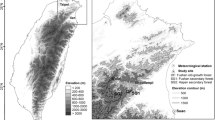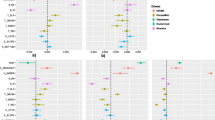Abstract
Our understanding of the effects of tropical cyclones on species composition and dynamics of forest communities is mainly derived from studies that have considered single cyclonic events. Here we examined changes in the tree species and functional trait composition in an 8-ha Dipterocarp forest at Palanan in the northeastern Philippines that is subject to a high frequency of cyclonic disturbance (1–4 cyclones annually). The plot has been censused four times over a 16-year interval allowing us to consider the medium-term forest dynamics in response to repeated cyclones. We hypothesized that as the forest community in Palanan has been selected under frequent disturbance by cyclones, it should show little functional change across the census intervals. We analyzed changes in demography, species composition, and community-weighted functional traits (specific leaf area, leaf area, wood density, and specific growth rate) across the censuses and compared these against cyclone intensities during the census intervals. Demographic changes across census years suggest that the community responded to cyclonic disturbances through substantial turnover in the small- and medium-size individuals, and that there has been an increase in plot-level stem density and basal area across the measured period. Trait compositional changes from 1994 to 2010 were mostly small, but indicate a shift towards species with larger leaves and faster growth rates—traits that are associated with fast recovery after disturbance. These changes all coincide with a large intense cyclone between the second and third censuses, suggesting that cyclone strength, more than cyclone frequency, affects this forest.


Similar content being viewed by others
References
Batista WB, Platt WJ. 2003. Tree population responses to hurricane disturbance: syndromes in a south-eastern USA old-growth forest. J Ecol 91:197–212.
Beard KH, Vogt KA, Vogt DJ, Scatena FN, Covich AP, Sigurdardottir R, Siccama TG, Crowl TA. 2005. Structural and functional responses of a subtropical forest to 10 years of hurricanes and droughts. Ecol Monogr 75:345–61.
Bellingham PJ, Tanner EVJ, Healey JR. 1995. Damage and responsiveness of Jamaican montane tree species after disturbance by a hurricane. Ecology 76:2562–80.
Blonder B, Buzzard V, Simova I, Sloat L, Boyle B, Lipson R, Aguilar-Beaucage B, Andrade A, Barber B, Barnes C, Bushey D, Cartagena P, Chaney M, Contreras K, Cox M, Cueto M, Curtis C, Fisher M, Furst L, Gallegos J, Hall R, Hauschild A, Jerez A, Jones N, Klucas A, Kono A, Lamb M, Matthai JDR, McIntyre C, McKenna J, Mosier N, Navabi M, Ochoa A, Pace L, Plassmann R, Richter R, Russakoff B, Aubyn HS, Stagg R, Sterner M, Stewart E, Thompson TT, Thornton J, Trujillo PJ, Volpe TJ, Enquist BJ. 2012. The leaf-area shrinkage effect can bias paleoclimate and ecology research. Am J Bot 99:1756–63.
Brown S. 1997. Estimating biomass and biomass change of tropical forests: a primer. FAO Forestry Paper—134. Rome, Italy: Food and Agriculture Organization of the United Nations.
Burslem DFRP, Whitmore TC, Brown GC. 2000. Short-term effects of cyclone impact and long-term recovery of tropical rain forest on Kolombangara, Solomon Islands. J Ecol 88:1063–78.
Chave J, Coomes D, Jansen S, Lewis SL, Swenson NG, Zanne AE. 2009. Towards a worldwide wood economics spectrum. Ecol Lett 12:351–66.
Christensen JH, Kanikicharla KK, Aldrian E, An S-I, Cavalcanti IFA, de Castro M, Dong W, Goswami P, Hall A, Kanyanga JK, Kitoh A, Kossin J, Lau N-C, Renwick J, Stephenson DB, Xie S-P, Zhou T. 2013. Climate phenomena and their relevance for future regional climate change. In: Stocker TF, Qin D, Plattner G-K, Tignor M, Allen SK, Boschung J, Nauels A, Xia Y, Bex V, Midgley PM, Eds. Climate change 2013: the physical science basis. Contribution of working group i to the fifth assessment report of the intergovernmental panel on climate change. Cambridge, United Kingdom and New York, New York, USA: Cambridge University Press.
Co LL, Lagunzad DA, LaFrankie JV, Bartolome NA, Molina JE, Yap SL, Garcia HG, Bautista JP, Gumpal EC, Araño RR, Davies SJ. 2004. Palanan forest dynamics plot, Philippines. In: Losos EC, Leigh EG Jr, Eds. Tropical forest diversity and dynamism: findings from a large-scale plot network. Chicago, USA: University of Chicago Press. p 574–84.
Co LL, LaFrankie JV, Lagunzad DA, Pasion KAC, Consunji HT, Bartolome NA, Yap SL, Molina JE, Tongco MDC, Ferreras UF, Davies SJ, Ashton PS. 2006. Forest trees of Palanan, Philippines: a study in population ecology. Quezon City, Philippines: Center for Integrative and Development Studies, University of the Philippines. p 313.
Condit R. 1998. Tropical forest census plots. Berlin, Germany and Georgetown, Texas, USA: Springer Verlag and R. G. Landes Company. p 222.
Emanuel K. 2005. Increasing destructiveness of tropical cyclones over the past 30 years. Nature 436:686–8.
Franklin J, Drake DR, McConkey KR, Tonga F, Smith LB. 2004. The effects of Cyclone Waka on the structure of lowland tropical rain forest in Vava’u, Tonga. J Trop Ecol 20:409–20.
Heartsill Scalley T, Scatena FN, Lugo AE, Moya S, Estrada Ruiz CR. 2010. Changes in structure, composition, and nutrients during 15 yr of hurricane-induced succession in a subtropical wet forest in Puerto Rico. Biotropica 42:455–63.
Kantha L. 2006. Time to replace the Saffir-Simpson hurricane scale? EOS Trans Am Geophys Union 87:3–6.
Kim H-J, Kim T-G, Kim E-H, Castillo ML, Cho D-S. 2011. Gap characteristics and natural regeneration in Mt. Makiling rainforest, the Philippines. J Ecol Field Biol 34:157–65.
Knutson TR, McBride JL, Chan J, Emanuel K, Holland G, Landsea C, Held I, Kossin JP, Srivastava AK, Sugi M. 2010. Tropical cyclones and climate change. Nat Geosci 3:157–63.
Kubota H, Chan JCL. 2009. Interdecadal variability of tropical cyclone landfall in the Philippines from 1902 to 2005. Geophys Res Lett 36:L12802.
Landsea C. 2007. Counting Atlantic tropical cyclones back to 1900. EOS Trans Am Geophys Union 88:2005–8.
Lin T-C, Hamburg S, Lin K-C, Wang L-J, Chang C-T, Hsia Y-J, Vadeboncoeur M, Mabry McMullen C, Liu C-P. 2011. Typhoon disturbance and forest dynamics: lessons from a northwest Pacific subtropical forest. Ecosystems 14:127–43.
Lohbeck M, Poorter L, Lebrija-Trejos E, Martinez-Ramos M, Meave JA, Paz H, Perez-Garcia EA, Romero-Perez IE, Tauro A, Bongers F. 2013. Successional changes in functional composition contrast for dry and wet tropical forest. Ecology 94:1211–16.
Lu X, Zang R, Huang J. 2015. Relationships between community level functional traits of trees and seedlings during secondary succession in a tropical lowland rainforest. PLoS One 10:e0132849.
Lugo AE. 2008. Visible and invisible effects of hurricanes on forest ecosystems: an international review. Austral Ecol 33:368–98.
Mann M, Emanuel K. 2006. Atlantic hurricane trends linked to climate change. EOS Trans Am Geophys Union 87:233.
Metcalfe DJ, Bradford MG, Ford AJ. 2008. Cyclone damage to tropical rain forests: Species- and community-level impacts. Austral Ecol 33:432–41.
Miura M, Manabe T, Nishimura N, Yamamoto S. 2001. Forest canopy and community dynamics in a temperate old-growth evergreen broad-leaved forest, southwestern Japan: a 7-year study of a 4-ha plot. J Ecol 89:841–9.
Poorter L, Wright SJW, Paz H, Ackerly DD, Condit R, Ibarra-Manriquez G, Harms KE. 2008. Are functional traits good predictors of demographic rates? evidence from five neotropical forests. Ecology 89:1908–20.
R Core Team. (2013). R: a language and environment for statistical computing. Vienna, Austria: R Foundation for Statistical Computing. [online] URL: http://www.R-project.org/.
Reich PB. 2014. The world-wide “fast-slow” plant economics spectrum: a traits manifesto. J Ecol 102:275–301.
Shiels AB, González G. 2014. Understanding the key mechanisms of tropical forest responses to canopy loss and biomass deposition from experimental hurricane effects. For Ecol Manag 332:1–10.
Shiels AB, Zimmerman JK, García-Montiel DC, Jonckheere I, Holm J, Horton D, Brokaw N. 2010. Plant responses to simulated hurricane impacts in a subtropical wet forest, Puerto Rico. J Ecol 98:659–73.
Slik JWF. 2006. Estimating species-specific wood density from the genus average in Indonesian trees. J Trop Ecol 22:481.
Swenson NG, Stegen JC, Davies SJ, Erickson DL, Forero-Montana J, Hurlbert AH, Kress WJ, Thompson J, Uriarte M, Wright SJ, Zimmerman JK. 2012. Temporal turnover in the composition of tropical tree communities: functional determinism and phylogenetic stochasticity. Ecology 93:490–9.
Webb EL, Seamon JO, Fa’aumu S. 2011. Frequent, low-amplitude disturbances drive high tree turnover rates on a remote, cyclone-prone Polynesian island. J Biogeogr 38:1240–52.
Webb EL, van de Bult M, Fa’aumu S, Webb RC, Tualaulelei A, Carrasco LR. 2014. Factors affecting tropical tree damage and survival after catastrophic wind disturbance. Biotropica 46:32–41.
Wilfahrt PA, Collins B, White PS. 2014. Shifts in functional traits among tree communities across succession in eastern deciduous forests. For Ecol Manag 324:179–85.
Wright SJ, Kitajima K, Kraft NJB, Reich PB, Wright IJ, Bunker DE, Condit R, Dalling JW, Davies SJ, Díaz S, Engelbrecht BMJ, Harms KE, Hubbell SP, Marks CO, Ruiz-Jaen MC, Salvador CM, Zanne AE. 2010. Functional traits and the growth-mortality trade-off in tropical trees. Ecology 91:3664–74.
Xu X, Hirata E, Shibata H. 2004. Effect of typhoon disturbance on fine litterfall and related nutrient input in a subtropical forest on Okinawa Island, Japan. Basic Appl Ecol 5:271–82.
Yamashita A, Sano J, Yamamoto S-I. 2002. Impact of a strong typhoon on the structure and dynamics of an old-growth beech (Fagus crenata) forest, southwestern Japan. Folia Geobot 37:5–16.
Zanne AE, Lopez-Gonzalez G, Coomes DA, Ilic J, Jansen S, Lewis SL, Miller RB, Swenson NG, Wiemann MC, Chave J. 2009. Data from: towards a worldwide wood economics spectrum. Dryad Digital Repository.
Zimmerman JK, Everham EMIII, Waide RB, Lodge DJ, Taylor CM, Brokaw NVL. 1994. Responses of tree species to hurricane winds in subtropical wet forest in Puerto Rico: implications for tropical tree life histories. J Ecol 82:911–22.
Acknowledgements
We would like to thank all the researchers and field assistants who were involved in the establishment and censuses of the Palanan Forest Dynamics Plot. The present study builds upon 20 years of collaborative work.
Author information
Authors and Affiliations
Corresponding author
Additional information
Author's contribution
Conceived of or designed the study: CCM, KWT, JWFS; Performed research: CCM, YI, NGS; Analyzed data: CCM, KWT, JWFS; Wrote the paper: CCM, KWT, YI, NGS, JWFS.
Electronic supplementary material
Below is the link to the electronic supplementary material.
Rights and permissions
About this article
Cite this article
Monoy, C.C., Tomlinson, K.W., Iida, Y. et al. Temporal Changes in Tree Species and Trait Composition in a Cyclone-prone Pacific Dipterocarp Forest. Ecosystems 19, 1013–1022 (2016). https://doi.org/10.1007/s10021-016-9983-0
Received:
Accepted:
Published:
Issue Date:
DOI: https://doi.org/10.1007/s10021-016-9983-0




